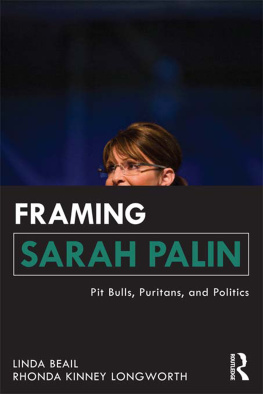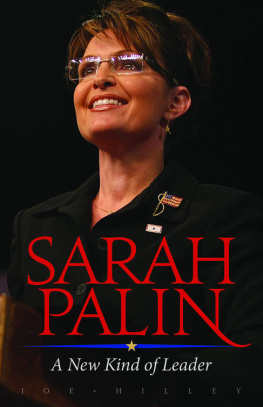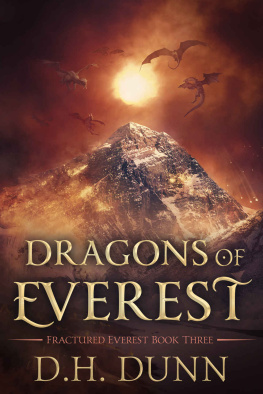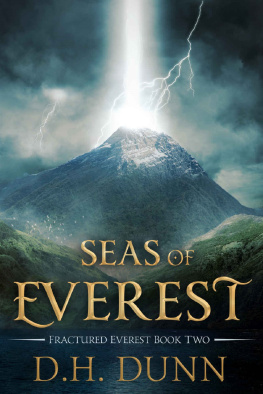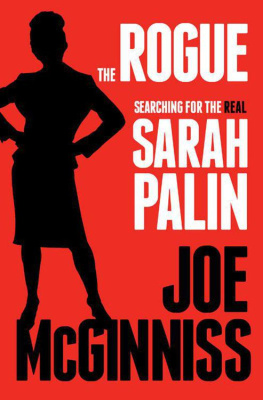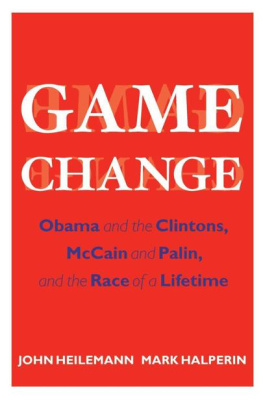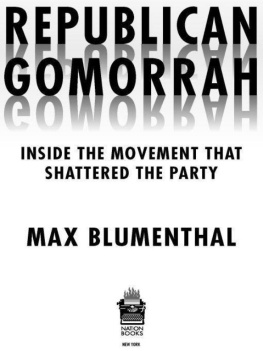
Contents
PROLOGUE
A truthful witness does not deceive,
but a false witness pours out lies.
Proverbs 14:5
Political Fictions: The Lies of Sarah Palin
Its like a really bad Disney movie, you know? Its a really terrifying possibility. The fact that weve gotten this farand were that close to this being a realityis crazy.
Matt Damon, interview with the Associated Press
Palins value to those patriarchs is clear: She opposes just about every issue that women support by a majority or plurality. She is Phyllis Schlafly, only younger.
Gloria Steinem, Los Angeles Times
She lied. But thats what she does. She lies. Over and over and over and over again. She is a liar.
Dan Fagan, The Alaska Standard
O N THE AFTERNOON OF F RIDAY , August 29, 2008, Sarah Palin suddenly appeared on the horizon of American politics like a dazzling comet from the far nether regions of the universe. Her spectacular alighting had all the makings of a political fairy tale. Never in the history of U.S. presidential elections had a candidate come from nowhere quite like this. Named as John McCains running mate on the Republican national ticket at a carefully scripted press conference in Dayton, Ohio, Palin captured successive twenty-four-hour news cycles throughout the weekend and stole any momentum that Barack Obama may have generated in the aftermath of his historic and triumphant acceptance speech only the night before at the Democratic National Convention in Denver. Shes not from these parts, and shes not from Washington, McCain intoned in one of the campaigns great understatements, but when you get to know her, youre going to be as impressed as I am. That McCain had spent less than a total of two full hours with his newly named running mate went unstated in Dayton, and it was kept, if only momentarily, from the rapidly spinning narrative of the 2008 presidential election.
Ever since her auspicious debut in Dayton, Sarah Louise Heath Palina woman of nearly infinite contradictions and a multitude of deceptionshas maintained a unique platform as both a conservative political icon and a powerful symbol of evangelical Christian values in the ever raging culture wars that engulf the United States in general, and the Republican Party in particular. With her fiery, indeed inflammatory, speech at the Republican National Convention in Minneapolis less than a week later, she not only established herself as a permanent, albeit polarizing, fixture in the American political conversation, she stopped cold the Obama machines propulsion heading into the final two months of the hotly contested battle for the American presidency. Single-handedly, and with a political rsum so thin some argued that you could see through it, the less than half-term governor from Alaska had momentarily reinvigorated the Republican Partyand most importantly, its conservative evangelical baseand had given it a newfound hope and energy for the impending November election.
In an age of instant celebrity, Palins had spontaneously combusted. Almost simultaneously, the national and, indeed, global media cast her as a maverick and rising star in American politics. She was the Republican Partys modern-day version of Cinderella. While the current historical memory of the moment contends that Palin was greeted with a harsh welcome, far too much of the incipient attention focused on her styleher folksy speech, her designer eyeglasses, her Tina Fey looks, her penchant for moose stew. She was portrayed as a prototypical, everyday American womana hockey mom who had just given birth to a son with Down syndrome. And she was glamorous . Television producers and newspaper reporters alike latched on to her widely publicized fashion spread in Vogue magazine six months earlier, in which she had been uncritically depicted as the golden girl of the Republican Party, a hardworking, pro-business politician whose friendly demeanor (that Palin smile!) made her palatable to the typical pickup-driving Alaskan man. Still other accounts centered on her celebrated categorization as the hottest governor from the coldest state. At a time in which political equations are often calculated by the lowest common denominator, Palins youthful vigor and girl-next-door sex appeal were viewed as vital complements to the presidential candidacy of the staid and elderly John McCain.
Indeed, the media covering the 2008 American presidential race were slow to the draw. While Palin had, in fact, been a controversial and polarizing figure in Alaska politics for sixteen years, her actual record as an elected officialas a council member and mayor of her hometown, Wasilla; as a failed candidate for lieutenant governor in 2002; as the controversial chair of the Alaska Oil and Gas Conservation Commission; and for twenty months as the contentious and once again polarizing governor of Alaskawent largely overlooked. The media bought into the Palin myth, one that she had carefully constructed and protected over the years, as a folksy, plain-speaking populist who had entered politics to take on the good ol boys network. Speaking from along the Glenn Highway that runs through Wasilla in the heart of Alaskas grand Matanuska Valley, MSNBC correspondent Savannah Guthrie reported that theres no question that she was a popular mayor here and she is a popular governor herefailing to mention a recall movement that formed against her in Wasilla and an even more freshly launched legislative investigation aimed directly at Palin for abuse of power in her governorship. And while the same media would grow harshly critical of her astonishing and seemingly endless faux pas along the campaign trail (and her familys equally endless private soap opera back in Wasilla), they never sufficiently vetted her on her well-documented and often problematic political career in Alaska, one that caromed recklessly out of control until her astonishing resignation as governor in July of 2009.
In Political Fictions, her brilliant analysis of the American polity, Joan Didion pointed out that the principal activity of a modern-day national presidential campaign is the construction of narratives both about, and around, the principal candidates and the shaping and reshaping of those narratives throughout the campaign. The primary target of these narratives is not the public at large (what the Greeks called the demos ), but a narrow group of selected target voters (moderates, independents, undecideds) who determine the outcome of each presidential election in a handful of critical swing states. Didion called these narratives political fictions, being made up of many such understandings, tacit agreements, small and large, to overlook the observable in the interests of obtaining a dramatic story line. In a fascinating account of the 2008 presidential campaign appearing in The New York Times Magazine, published just before Election Day, Robert Draper noted that the selling of a presidential narrativethe reigning buzz word of this election cyclehas taken on outsize significance in an age in which a rush of visuals and catch words can cripple public images overnight. A national candidates chief political cachet in the Information Ageand this goes for both partiesis to have a good story, which is precisely what Barack Obama said about Sarah Palin in the aftermath of her nomination.
Palin and the McCain spinmeisters constructed a narrative about her life as a dutiful mother of five, who gave of her time and energy to better her community in Alaska and cut down on taxes; that as governor of Alaska, she took on the good ol boys network that had dominated the Last Frontier for the past fifty years, holding herself to a higher standard than her predecessors. The reality was and is far more complicated. What strikes one most vividly about such a campaign, Didion lamented, is precisely its remoteness from the real life of the country. Perhaps it should not be surprising, then, that more than two years after her entre into national politics, after several fawning hagiographies written about her and a ghostwritten (and bestselling) personal memoir, much of Palins political career still remains largely overlooked, along with the early, formulative details of her life in Wasilla.
Next page


